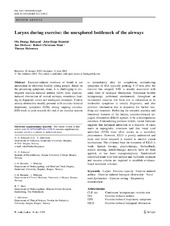| dc.contributor.author | Røksund, Ola Drange | en_US |
| dc.contributor.author | Heimdal, John-Helge | en_US |
| dc.contributor.author | Olofsson, Jan | en_US |
| dc.contributor.author | Maat, Robert | en_US |
| dc.contributor.author | Halvorsen, Thomas | en_US |
| dc.date.accessioned | 2015-03-25T14:02:04Z | |
| dc.date.available | 2015-03-25T14:02:04Z | |
| dc.date.issued | 2014-07-18 | eng |
| dc.identifier.issn | 0937-4477 | |
| dc.identifier.uri | https://hdl.handle.net/1956/9656 | |
| dc.description.abstract | Exercise-induced shortness of breath is not uncommon in otherwise healthy young people. Based on the presenting symptoms alone, it is challenging to distinguish exercise-induced asthma (EIA) from exercise-induced obstruction of central airways, sometimes leading to diagnostic errors and inadequate treatment. Central airway obstruction usually presents with exercise-induced inspiratory symptoms (EIIS) during ongoing exercise. EIIS tends to peak towards the end of an exercise session or immediately after its completion, contradicting symptoms of EIA typically peaking 3–15 min after the exercise has stopped. EIIS is usually associated with some form of laryngeal obstruction. Transnasal flexible laryngoscopy performed continuously throughout an incremental exercise test from rest to exhaustion or to intolerable symptoms is usually diagnostic, and also provides information that is important for further handling and treatment. Reflecting the complex anatomy and functional features of the larynx, exercise-induced laryngeal obstruction (EILO) appears to be a heterogeneous condition. Contradicting previous beliefs, recent literature suggests that laryngeal adduction in a majority of cases starts in supraglottic structures and that vocal cord adduction (VCD) most often occurs as a secondary phenomenon. However, EILO is poorly understood and more and better research is needed to unravel causal mechanisms. The evidence base for treatment of EILO is weak. Speech therapy, psychotherapy, biofeedback, muscle training, anticholinergic aerosols have all been applied, as has laser supraglottoplasty. Randomized controlled trials with well-defined and verifiable inclusion and success criteria are required to establish evidence-based treatment schemes. | en_US |
| dc.language.iso | eng | eng |
| dc.rights | Attribution CC BY | eng |
| dc.rights.uri | http://creativecommons.org/licenses/by/4.0 | eng |
| dc.subject | Larynx | eng |
| dc.subject | Exercise capacity | eng |
| dc.subject | Exercise-induced asthma | eng |
| dc.subject | Exercise-induced laryngeal obstruction | eng |
| dc.subject | Vocal cord dysfunction | eng |
| dc.subject | Exercise testing | eng |
| dc.subject | Respiratory measurement | eng |
| dc.title | Larynx during exercise: the unexplored bottleneck of the airways | en_US |
| dc.type | Peer reviewed | |
| dc.type | Journal article | |
| dc.date.updated | 2015-03-05T07:43:47Z | en_US |
| dc.description.version | publishedVersion | en_US |
| dc.rights.holder | Copyright 2014 The Authors | |
| dc.identifier.doi | https://doi.org/10.1007/s00405-014-3159-3 | |
| dc.identifier.cristin | 1163036 | |
| dc.source.journal | European Archives of Oto-Rhino-Laryngology | |
| dc.subject.nsi | VDP::Medical sciences: 700::Clinical medical sciences: 750::Otolaryngology: 755 | eng |
| dc.subject.nsi | VDP::Medisinske fag: 700::Klinisk medisinske fag: 750::Otorhinolaryngologi: 755 | nob |

